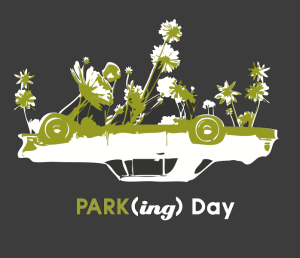 It is estimated that more than 35 million square feet of land in the United States is used not for growing food or flowers, for enhancing community livability or for encouraging physical activity. Rather, more than 35 million square feet of land in the United States is used for the parking of cars. On-street parking dominates our streets. How would the social and physical landscape change if parking spots were people spots? If our streets were designed not just to move cars, but to facilitate people and social interaction? This is the question that communities across the world will be asking this Friday, September 20 on “PARK(ing) Day.”
It is estimated that more than 35 million square feet of land in the United States is used not for growing food or flowers, for enhancing community livability or for encouraging physical activity. Rather, more than 35 million square feet of land in the United States is used for the parking of cars. On-street parking dominates our streets. How would the social and physical landscape change if parking spots were people spots? If our streets were designed not just to move cars, but to facilitate people and social interaction? This is the question that communities across the world will be asking this Friday, September 20 on “PARK(ing) Day.”
PARK(ing) Day started in San Francisco in 2005 when Rebar, a San Francisco art and design firm, lamenting the lack of park space in the city, turned a single metered space in the city’s downtown to a temporary public park. Since then PARK(ing) Day has become an annual worldwide event in which artists, designers, planners and concerned, active citizens, transform metered parking spaces in highly visible areas into temporary parks. Throughout the day, the mini-parks are used for typical park activities (picnics, reading, etc.) and people who pass by are encouraged to indulge in the newly created park space. Like that, the street is no longer just for cars; the street has become people-centered.
In 2011, there were over 900 mini-parks in parking spaces in 162 cities, spread out over 35 countries on 6 continents.
PARK(ing) Day aims to provoke a conversation about how we view and value urban space. The day aims to show just how powerful it can be if we orient our street design for people, in ways that encourage community, facilitate conversation, promote health and encourage economic activity.
And when you give people the keys to a parking space, you’d be amazed at the creativity that results.
After laying down sod or astroturf, putting down benches to create the basics of a park (and, of course feeding the meter to “officially” lease the space,) people start to get creative. Communities have hosted yoga and urban farming demonstration in the spots; set up mini-golf courses, brought out grand pianos and teeter totters; played games like twister and connect four; and hosted potlucks. Barbers have even been known to set up shop in these rogue parks. All the while, the participants are challenging existing notions of public urban space and pushing people to rethink the way streets are used.
San Francisco’s PARK(ing) Day was so successful and groundbreaking that the city started a parklet program, aptly known as their “Pavement to Parks” initiative, where businesses and community members team up to create permanent mini-parks in parking spaces.
There are over 8,000 public parking spaces in downtown Ann Arbor, where I live. There are 0 public parks in the downtown area. There is no grass in downtown Ann Arbor.
My community will be certainly be leasing a parking space on Friday. We’ve worked with the Ann Arbor Downtown Development Authority to secure a space and contacted local businesses who will be donating food. People are excited. We’re starting a conversation about space. Will your community? Why not?




